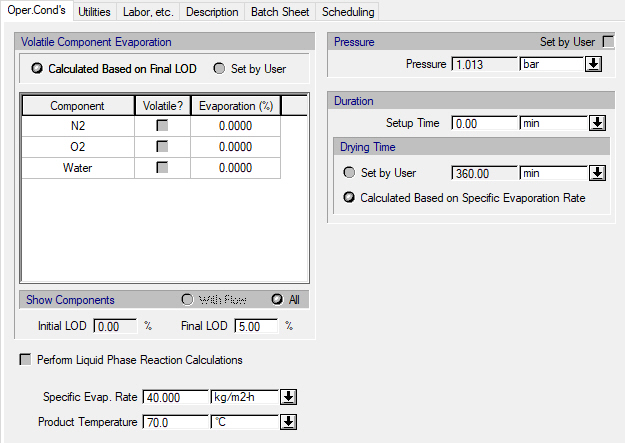

The following table shows a brief description of the variables appearing in this tab. The table also displays their default values and their generally acceptable range:
|
Variable |
Default Value |
Range |
|
|
||
|
○ Volatile ? |
<No> |
Yes/No |
|
◙ Evaporation (%) |
0.0 |
0-100 |
|
● Initial LOD (%) |
0.0 |
0-100 |
|
○ Final LOD (%) |
5.0 |
0-100 |
|
○ Perform Liquid Phase Reaction Calculations? |
<No> |
Yes/No |
|
◙ Specific Evaporation Rate (kg/m2-h) |
40.0 |
Positive |
|
◙ Product Temp. (C) |
70.0 |
Positive |
|
○ Pressure Set by User |
No |
Yes/No |
|
◙ Pressure (atm) |
1.0 |
Positive |
|
○ Vacuum Pump |
<none> |
Any Vacuum Pump |
|
○ Vacuum Pump Power (kW) |
0.0 |
Positive |
|
○ Setup Time |
0.0 |
Positive |
|
● Drying Time (h) |
6.0 |
Positive |
Symbol Key: ○ User-specified value (always input); ● Calculated value (always output); ◙ Sometimes input, sometimes output
The following list describes the available specification choices in this tab; for more details on how these are implemented, see Drum Drying: Modeling Calculations.
•Volatile?...
All volatile components that are removed (evaporated) during drying must be identified as such.
•Volatile Component Evaporation...
If the evaporation of volatile components is calculated by the program based on Final LOD, then it is assumed that all volatile components have the same evaporation %. If that is not the case, then you need to set the evaporation percentage of the various volatile components.
The ‘Evaporation Rate’ variable is input in Design Mode and output in Rating Mode.
•Duration Options...
The duration options are only displayed if the procedure operating mode is set to batch. If the process operating mode is also batch and the equipment is in rating mode, you can either specify the drying time or the specific evaporation rate. If the process operating mode is continuous or the equipment is in design mode, you must specify the drying time.
•Specific Evaporation Rate...
If the process operating mode and procedure operating mode are set to batch, then if the equipment is in design mode you must specify the specific evaporation rate and if the equipment is in rating mode you can either specify the drying time or the specific evaporation rate. If the process operating mode or procedure operating mode is continuous, then you must specify the specific evaporation rate only if the equipment is in design mode. If the equipment is in rating mode, the specific evaporation rate will be calculated by the program.
•Vacuum Pump Controls...
Note that the vacuum pump controls are only displayed if the operating pressure is less than the ambient pressure (specified through the flowsheet’s Reference Conditions dialog).
Click on the vacuum pump list box to bring up a list of available vacuum pumps in order to select one, or select “(none)” (default) if equipment sizing, costing and scheduling calculations are not important.
To create a new vacuum pump and add it to the list of available vacuum pumps, click on the New button ( ). This will open the Auxiliary Equipment Properties dialog for auxiliary equipment of the vacuum pump type (see Auxiliary Equipment Properties Dialog: Aux. Equipment tab (Vacuum Pump)). Through this dialog, you can view or edit the properties of the auxiliary equipment resource (e.g., name, size, purchase cost, consumables, scheduling).
). This will open the Auxiliary Equipment Properties dialog for auxiliary equipment of the vacuum pump type (see Auxiliary Equipment Properties Dialog: Aux. Equipment tab (Vacuum Pump)). Through this dialog, you can view or edit the properties of the auxiliary equipment resource (e.g., name, size, purchase cost, consumables, scheduling).
The same dialog is displayed if you select one of the available vacuum pumps from the list and click on the View/Edit Properties button ( ).
).
Click on the Setup button to display the Vacuum Pump Consumption dialog (see Vacuum Pump Power Consumption Dialog), and select different options for specifying the power consumption of the vacuum pump. By default, the vacuum pump power specification option is “Set Total Power” and the total power consumption of the vacuum pump can be set by the user (the default value is zero). For more information, see Vacuum Pump Auxiliary Equipment Calculations.